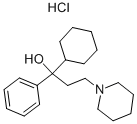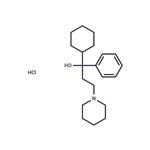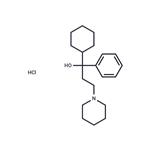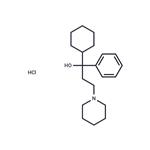Trihexyphenidyl is an antagonist of M1 muscarinic acetylcholine receptors. It binds to rat M1 receptors in cerebral cortex selectively over rat M2 receptors in heart tissue (IC50s = 3.7 and 31 nM, respectively). Trihexyphenidyl inhibits contractions induced by acetylcholine in guinea pig ileum (IC50 = 22 nM). It also inhibits oxotremorine-induced tremors and physostigmine-induced mortality in mice (ED50s = 2 and 3.6 mg/kg, respectively). Trihexyphenidyl (20 mg/kg) improves abnormal movement in a mouse model of L-3,4-dihydroxyphenylalanine (L-DOPA) responsive dystonia (DRD) that expresses mutant tyrosine hydroxylase (TH). Formulations containing trihexyphenidyl have been used in the symptomatic treatment of Parkinson''s disease.
Benzhexol hydrochloride is White Solid
anticholinergic, antiparkinsonian
Benzhexol hydrochloride is an anticholinergic tertiary amine that can gain access to the CNS. It is used to treat parkinsonism and the extrapyramidal side effects of anti-psychotic drugs. The drug is a muscarinic anta gonist that qualitatively resembles the belladonna alkaloids in its pharmacological actions and side effects.
ChEBI: Trihexyphenidyl hydrochloride is an aralkylamine.
Acetophenone, paraformaldehyde and piperidine are first reacted to give ω-(1-
piperidyl)propiophenone.
To an absolute ethyl ether solution of cyclohexylmagnesium bromide
(prepared from 261 parts of cyclohexyl bromide, 38.8 parts magnesium
turnings and 700 parts by volume absolute ethyl ether) a dry solution of 174
parts omega-(1-piperidyl)-propiophenonein 600 parts by volume of ether is
added, with stirring, at such a rate that gentle reflux is maintained with no
external cooling or heating. The reaction mixture is stirred for about 5 hours
and then allowed to stand at room temperature until reaction appears
complete. While being cooled the reaction mixture is then decomposed by the
dropwise addition of 500 parts by volume of 2.5 N hydrochloric acid, and
finally is made strongly acidic to Congo red by the addition of concentrated
hydrochloric acid.
The resulting white solid is collected on a filter, air dried, redissolved in 2,500
parts water at 95°C and the resulting solution treated with decolorizing
charcoal and clarified by filtration. The cooled filtrate is made alkaline with
ammonia and the product, crude 3-(1-piperidyl)-1-cyclohexyl-1-phenyl-1-
propanol is collected. The hydrochloride melts with decomposition in ten
seconds in a bath held at 258.5°C. The alcohol melts at 114.3° to 115.0°C,
according to US Patent 2,716,121.
Artane (Lederle); Tremin (Schering).
Trihexyphenidylhydrochloride, α-cyclohexyl-α-phenyl-1-piperidinepropanolhydrochloride (Artane, Tremin, Pipanol), introduced in1949, is approximately half as active as atropine as an antispasmodicbut is claimed to have milder side effects, such asmydriasis, drying of secretions, and cardioacceleration. It hasa good margin of safety, although it is about as toxic as atropine.It has found a place in the treatment of parkinsonismand is claimed to provide some measure of relief from themental depression often associated with this condition. It does, however, exhibit some of the side effects typical of theparasympatholytic-type preparation, although adjusting thedose carefully may often eliminate these.
Common side effects of Benzhexol hydrochloride include drowsiness, dizziness, constipation, flushing, nausea, nervousness, blurred vision or dry mouth. Severe may include: decreased sexual performance, severe stomach/abdominal pain, difficulty/pain in swallowing, difficulty in urinating, chest pain, severe dizziness/fainting, high fever, fast/irregular/slow heartbeat, mental/mood changes (e.g., blurred consciousness, hallucinations, memory problems), pain/swelling/reddening of the eyes, changes in vision (e.g., seeing rainbows around lights at night). Symptoms of very severe allergic reactions in some patients include: rash, itching/swelling (especially of the face/tongue/throat), severe dizziness, and difficulty breathing. In addition, studies have shown that Benzhexol hydrochloride has minimal side effects in the treatment of salivation in children with cerebral palsy.
Poison by ingestion,intraperitoneal, intravenous, and subcutaneous routes. Ananticholinergic agent which causes human psychotropiceffects. Human systemic effects by ingestion: distortedperceptions, eye effects, hallucinations, toxic psychosis.When he



